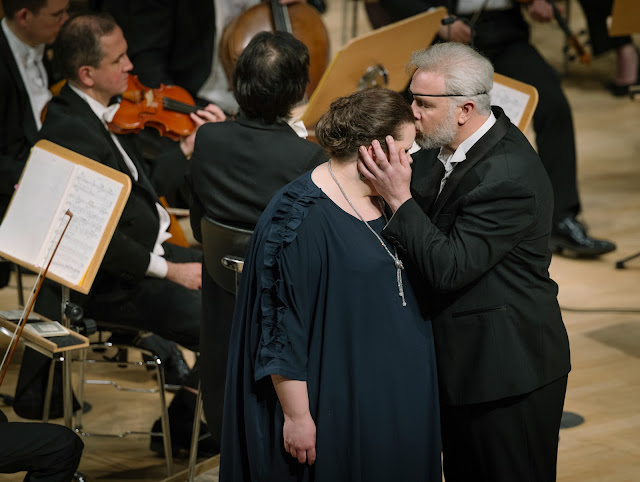 |
| Wagner: Die Walküre - Åsa Jäger, Simon Bailey - Dresdner Musikfestspiele (Photo: Oliver Killig) |
Wagner: Die Walküre; Maximilian Schmitt, Sarah Wegener, Tobias Kehr, Simon Bailey, Åsa Jäger, Claude Eichenberger, Dresdner Festspielorchester and Concerto Köln, Kent Nagano; Dresdner Musikfestspiele at the Kulturpalast, Dresden
Reviewed 9 May 2024
One of those evenings about which you can say 'I was there'. Revelations and riveting drama as the Dresden Music Festival unfolded the next installment of its historically informed Ring Cycle
Creating a Ring Cycle is a journey, few can come to the cycle with their thoughts and ideas perfectly formed. For the Dresdner Musikfestspiele (Dresden Music Festival) this is even more so. Not only is their Ring Cycle, which opened last year with Das Rheingold [see my review] and is planned to unfold annually, their biggest project to date, but it is taking an historically informed approach. So, for many of those involved, period instrument specialists whose performing lives centre on 18th and early 19th century music, this is a first approach to Wagner on this scale.
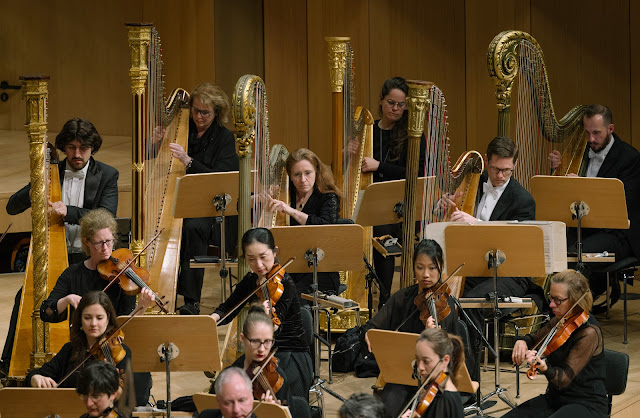 |
| Wagner: Die Walküre - Dresdner Festspielorchester and Concerto Köln - Dresdner Musikfestspiele (Photo: Oliver Killig) |
When I chatted to the festival's Intendant, Jan Vogler, just before this year's installment of the Ring Cycle in Dresden, Die Walküre; he explained that the Wagner project came about through a combination of circumstances. Now the Dresdner Festspielorchester is over ten years old, Jan was looking for a project for them. He had been a friend and colleague of Kent Nagano for many years. Nagano and Concerto Köln were looking for ways to continue their Wagner project. Their initial research phase complete, the project became too big for Concerto Köln to continue alone.
But also there was Jan's feeling that festivals grow by creating their own productions. There was the added frisson of completing Wagner's Ring in Dresden, where Wagner went to school, and was later music director. But in the soap opera of the composer's life, he was also involved in revolutionary activities and forced to leave. Having seized the idea, to make it happen the festival had to up its game and raise around 10 million Euros to cover the complete Ring as well as expanding the festival team and finding musicologists to be involved in the project. At first the sheer scope was a shock, but the team came to fall in love with their own Wagner project.
The historically informed approach to the Ring is new territory and not standard, with the instrumentalists concentrating on music of earlier periods. So that the players, rather than coming to Wagner via later music, are more like Wagner's contemporaries having little prior experience of playing his music. Jan describes Kent Nagano as a perfectionist, with a sharp ear. Jan talked about the way many conductors simply take whatever an orchestra delivers and work with that, but Nagano searches for the performance he can hear, and lots of due diligence is done.
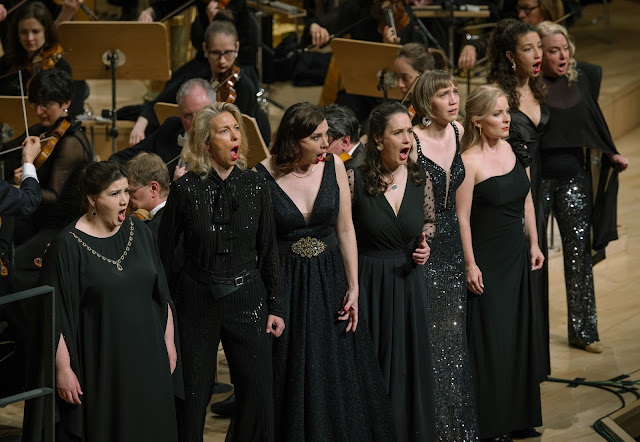 |
| Wagner: Die Walküre - The Valkyries - Dresdner Musikfestspiele (Photo: Oliver Killig) |
The Ring Cycle is also a great chance for the festival as they slowly come to understand how large projects are created. The cycle is being recorded and will be issued on disc. There is talk of what next, after the final installment in 2026. The idea of a complete Ring Cycle has garnered some interest, and Jan admits that it is quite appealing, but as ever the issue remains one of money.
The performance of Die Walküre in Dresden was the final one of a short tour that included Amsterdam, Prague, Cologne and Hamburg's Elbphilharmonie. On Thursday 9 May 2024 at the Kulturpalast, Dresden, Kent Nagano conducted the combined forces of the Dresdner Festspielorchester and Concerto Köln in Wagner's Die Walküre with Maximilian Schmitt as Siegmund, Sarah Wegener as Sieglinde, Tobias Kehrer as Hunding, Simon Bailey as Wotan, Åsa Jäger as Brünnhilde and Claude Eichenberger as Fricka. The project is a collaboration with the Wagner Cycles and the academic aspect is important with a whole day of presentations at the Kulturpalast before the performance.
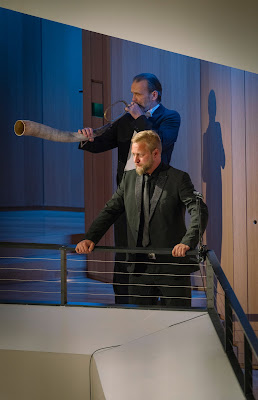 |
| Wagner: Die Walküre - Martin Schlegel, Tobias Kehrer Dresdner Musikfestspiele (Photo: Oliver Killig) |
For all the largeness of the forces involved, this was a performance notable for its quiet moments, the way textures could thin out. The playing did not have the high-gloss sheen you get from modern instruments and the playing style certainly did not have the sense of long familiarity that comes with experience such as at Bayreuth. What we had here was that feeling of exploration, of charting new territory. With the singers, an important factor was the project's interest in the way Wagner's music was declaimed, the mixture of words and music. Text was extremely important here, this performance was one where you really noticed Wagner's distinctive use of Stabreim.
The singers were relatively youthful, Maximilian Schmitt, Sarah Wegener and Åsa Jäger were all firmly in the jugend dramatisch side, with Åsa Jäger having made her debut as Brünnhilde in 2022, and I don't think that I have ever before coma across a Siegmund who included a tour as Evangelist in Bach's St Matthew Passion as part of their CV.
For Act One, what came across was the detail and fluidity of the dialogue. Not naturalistic, but certainly lacking the portentousness of some Wagner performances. Both Schmitt and Wegener evoked the operas of Weber (an important precursor to Wagner), both singers had a youthful brightness of tone and vocal flexibility, a lightness of touch in the dialogue allied to an element of steel where needed. Wegener was impressive for the sheer amount of telling detail in her performance, both musically and physically. She was well attuned to the orchestra, and reacted when Sieglinde's musical material played in the orchestra. Maximilian Schmitt made an impressive Siegmund, vibrant in 'Du bist der Lenz' but youthfully ardent as well. Both singers sparked off each other and we had a real sense of the desire the flowed through each character.
Tobias Kehrer was a fantastically black-voiced Hunding, physically threatening yet attractive too. Perhaps a he overdid the threat, but with that voice you forgave him much and he certainly made a contrast to the two other performers' youthful ardour in Act One.
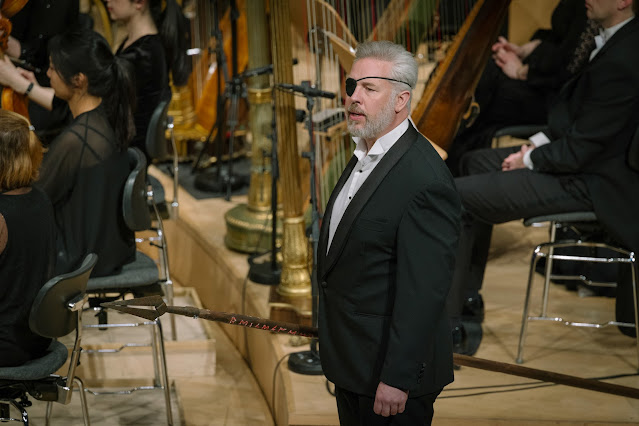 |
| Wagner: Die Walküre - Simon Bailey - Dresdner Musikfestspiele (Photo: Oliver Killig) |
With Act Two, Simon Bailey provided a strong focus as Wotan, mesmerising in his sheer identification with the text and the flexibility of delivery. Here we had the world weariness but also his love for Jäger's Brünnhilde; he and Jäger made their dialogues rather intimate. There was a different kind of intimacy in Bailey's scenes with Eichenberger's Fricka, the feeling of a couple picking up arguing where they'd left off before. Eichenberger was less a harridan as Fricka, but still giving a finely detailed performance so that she and Bailey drew muted sparks. In Act Two, Jäger impressed with the way she moved fluidly between the top Cs of her battle cry and the rest of the music, with is lower lying. And throughout the act, you felt Nagano's control of the flow of the music, the larger fluid paragraphs.
When Schmitt and Wegener returned later in the act, they were just as compelling with Wegener in particular being transformed as Sieglinde's anxieties rose. Jäger had a strong physical presence in the Todesverkündigung, she was wonderfully intent and watchful. Perhaps not quite as wedded to the text as some of the other performers, but she balanced this with a lovely physical ease in her delivery, a sense of the lyricism of this music, and a finely focused middle and lower register allied to that easy top. The conclusion to Act Two, minimally staged with Schmitt and Kehrer in the balcony above the orchestra, and with Kehr accompanied by Martin Schlegel on stierhorn (a long cow horn welded to a bugle), leaving the front stage to Bailey (complete with spear), Jäger and Wegener, had an effectiveness that many more complex stagings could have envied.
Everyone had the time of their lives in the opening of Act Three. This scene is always a glorious noise, and here we had the added advantage of the colourful sense of timbre that came from the period brass. Nagano brought tight excitement to the music, complemented by the bright, youthful voices of the eight Walküre (Chelsea Zurflüh, Natalie Karl, Ulrike Malotta, Jasmin Etminan, Karola Sophia Schmid, Ida Aldrian, Eva Vogel, Marie-Luise Dressen) all of whom brought the requisite light-heartedness to their performance allied to glamour in the appearance.
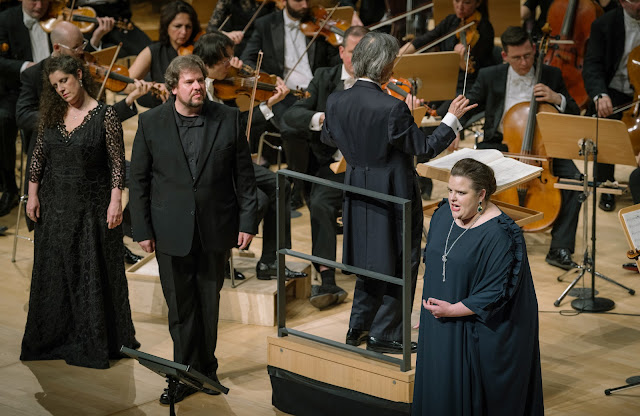 |
| Wagner: Die Walküre - Sarah Wegener, Maximilian Schmitt, Åsa Jäger - Dresdner Musikfestspiele (Photo: Oliver Killig) |
Sieglinde's glorious affirmation when told of her pregnancy, clearly took Wegener to the limits of the possible, but she projected with fine intensity. Jäger's Brünnhilde had interesting undercurrents to her performance as strong emotions flitted across her watchful face. Youthful and intent, this was a genuinely ardent Brünnhilde, moved by her sympathy for Siegmund. The whole scene with Bailey's Wotan was moving, simply yet effectively staged, you felt the intensity of feeling between father and daughter.
Wotan's final scene is as much orchestral as vocal and whilst Bailey brought a moving sense of identification with both music and text, he sang trenchantly, rather then giving us a suave line, but surrounded by the miraculous web of instrumental colours. Magic fire music indeed.
The singers were all off the book, though one or two seemed more in need of the prompt. The staging was admirably minimal but the personenregie was far more detailed than in some productions so that the various dialogues in which the opera unfolds were all well projected, and the interactions between Schmitt and Wegener, and between Bailey and Jäger were particularly vivid.
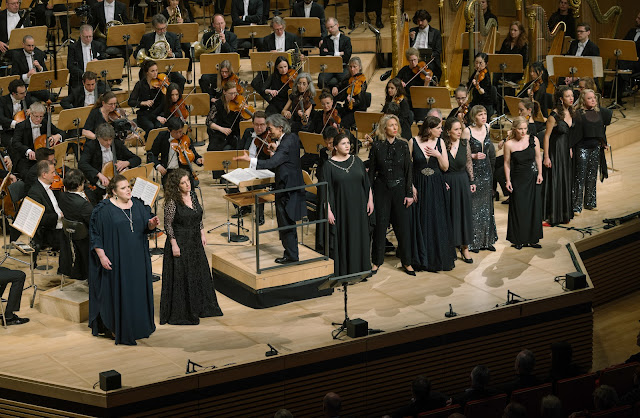 |
| Wagner: Die Walküre - Åsa Jäger, Sarah Wegener, Kent Nagano, Valkyries, Dresdner Festspielorchester and Concerto Köln - Dresdner Musikfestspiele (Photo: Oliver Killig) |
Never miss out on future posts by following us
The blog is free, but I'd be delighted if you were to show your appreciation by buying me a coffee.
Elsewhere on this blog
- International Handel Festival, Göttingen
- Göttingen 1853: Johannes Brahms & Joseph Joachim, a meeting of musical minds evoked - concert review
- Quite a Summer: Tom Fetherstonhaugh and Fantasia Orchestra have three festival debuts including the BBC Proms - interview
- Dresden Music Festival
- The results were indeed glorious: Klaus Mäkelä and the Royal Concertgebouw Orchestra in Bruckner - concert review
- The journey continues: Dresden's historically informed Ring returns with a revelatory Die Walküre - opera review
- Mozart in 1774: Samantha Clarke, Jane Gower, The Mozartists, and Ian Page on stylish form at Wigmore Hall - interview
- Vigour, energy & joy: A Choral Celebration of Queen Mary II from choirs of Royal Hospital Chelsea & Old Royal Naval College - concert review
- A neglected gem revived: New Sussex Opera in Lampe's The Dragon of Wantley combining historic style and 1980s politics - opera review
- Lobesgesang: Mendelssohn's rarely performed symphony-cantata is a fine climax to Sir Andras Schiff and the OAE's exploration of the composer's symphonic music - concert review
- Fear no more: Brindley Sherratt on releasing his first recital disc - interview
- A German in Venice: Schütz alongside music he could have heard in Venice, a wonderfully life-affirming disc - record review
- Attention must be paid: the Engegård Quartet at Conway Hall in Mozart, Bartok, Maja Ratkje, and Fanny Mendelssohn - concert review
- Opera as it ought to be: Mozart's Don Giovanni from Hurn Court Opera reviewed by James McConnachie - opera review
- Home

.jpg)









No comments:
Post a Comment